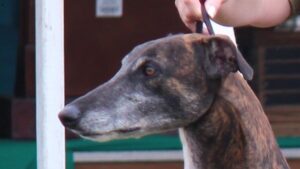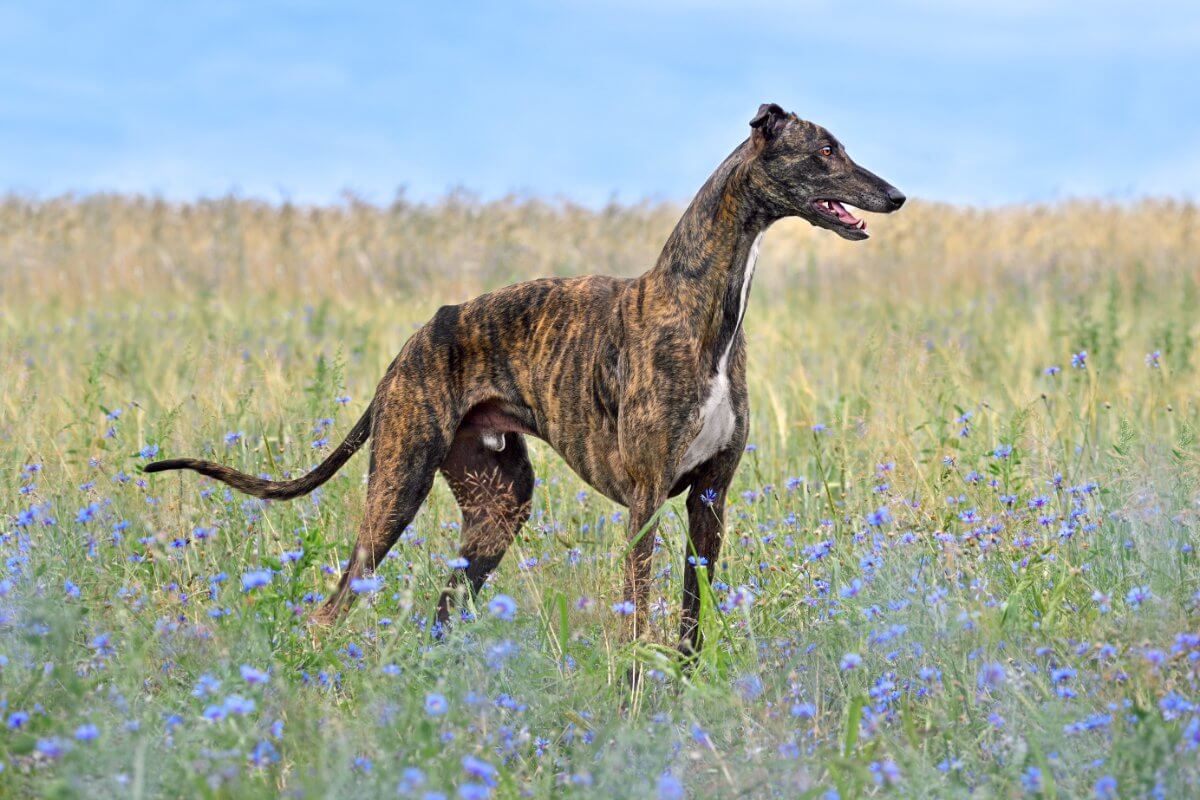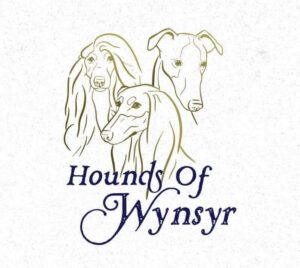
The Greyhound
Unlock the essence of the Greyhound breed, offering a deep dive into its unique anatomy, judging priorities, and defining topline traits.
Home » Dog Breeds » Greyhound Dog Breed


The Greyhound, known for its iconic, sleek profile and unmatched speed, is one of the most recognizable of all dog breeds. Traditionally celebrated as a hunter and courser due to its keen sight and swiftness, these sighthounds have also made a name for themselves in dog racing arenas. However, beyond the tracks and fields, Greyhounds are adored for their gentle disposition and affectionate nature, making them cherished companions in many households today.
Hound
27 – 30 Inches
60 – 70 Pounds
10 – 13 Years
| Country of Origin | England |
|---|---|
| Bred For | Coursing, Companionship |
| Known For | Aerodynamic Silhouette, Racing, Gentle Nature |
| Popularity | Moderate |
| Temperament | Independent, Noble, Sweet-Tempered |
| Activities | Hunting, Running, Hiking, Conformation Shows, Dog Sports |
The Greyhound is a sighthound prototype. The breed’s history is as illustrious as it is lengthy, weaving a tale that combines both myth and reality.
The origins of the Greyhound can be traced back over 4,000 years to civilizations in ancient Egypt, Greece, and Persia. Egyptian artifacts and murals from as early as 3,000 BC depict slender, long-legged canines that closely resemble modern-day Greyhounds. Dogs of this type were revered by the Pharaohs and often mummified and buried with them to accompany their masters in the afterlife. Hieroglyphics found in the pyramids even suggest that these dogs were considered gods.
The Greyhound’s presence was also pronounced in ancient Greece, where the dogs were celebrated in both art and literature. It was mentioned by revered poets such as Homer in his epic, The Odyssey. In Rome, they were both hunting companions and racing dogs, showcasing their dual speed and sight skill sets.
The Greyhound’s journey then took them by the Romans to Europe, where they were highly prized by the nobility for their hunting prowess. In England, they were so esteemed that, for a period, commoners were prohibited from owning them. The name “Greyhound” is believed to derive from the Olde English “Grighund.” The name’s meaning is not entirely clear, but it is said to refer to a “fine dog” rather than to have any reference to the hound’s color.
By the 18th and 19th centuries, coursing with Greyhounds, where the dogs would chase live game, became a popular sport in England. However, with concerns over animal welfare, that enterprise gradually shifted to the more familiar form of track racing, which uses a mechanical lure. That sport began in the early 20th century in the United States, and quickly gained popularity, leading to the construction of Greyhound racetracks across the country.
The Greyhound was among the first breeds to be registered when The Royal Kennel Club (UK) was formed in 1873. The American Kennel Club (AKC) followed suit, officially recognizing the breed in 1885. The Fédération Cynologique Internationale (FCI) also acknowledges the Greyhound, highlighting its long-standing global significance as an iconic purebred.
In recent decades, Greyhound racing has faced controversy due to ethical and animal welfare concerns. As a result, many tracks have closed, leading to large numbers of retired racing Greyhounds becoming available for adoption. Fortunately, adoption groups were established to ensure these dogs find loving homes in their post-racing lives.
Today, the Greyhound’s storied past paints a picture of a breed that has been both a cherished companion and a celebrated athlete. Its journey from the sands of ancient Egypt to contemporary homes worldwide is a testament to the breed’s enduring charm and social significance.
Adult male Greyhounds typically stand between 28 and 30 inches tall at the shoulders, while mature females usually measure 27 to 28 inches tall.
In terms of weight, males generally weigh between 65 and 70 pounds, and females range from 60 to 65 pounds.
The Greyhound is blessed with harmonious proportions, giving this elegant sighthound its distinctively aerodynamic silhouette. The breed’s long legs are muscular and powerful, allowing for its renowned speed and agility. Substance-wise, Greyhounds are lean yet muscular. Their streamlined form is devoid of excess bulk, but they possess a robust skeletal structure that supports their many athletic endeavors.
Texture: The Greyhound’s coat is short, fine, and smooth to the touch. It is dense, providing the dog with some protection against the elements while also showcasing its sleek, athletic physique. The short, smooth coat requires little in the way of maintenance.
| Standard Color | |
|---|---|
| Black | ee |
| Black Brindle | ee |
| Blue Brindle | ee |
| Red | ee |
| Red Brindle | ee |
| White | ee |
| White & Black | ee |
| White & Blue Brindle | ee |
| White & Red | ee |
| Blue | ee |
| Blue Fawn | ee |
| White & Black Brindle | ee |
| White & Blue | ee |
| White & Blue Fawn | ee |
| White & Red Brindle | ee |
| Black & White | ee |
| Blue Brindle & White | ee |
| Red & White | ee |
| Black Brindle & White | ee |
| Blue & White | ee |
| Blue Fawn & White | ee |
| Fawn | ee |
| Fawn & White | ee |
| Liver | ee |
| Liver & White | ee |
| Liver Brindle | ee |
| Red Brindle & White | ee |
| White & Fawn | ee |
| White & Liver | ee |
| White & Liver Brindle | ee |
| Standard Marking | |
|---|---|
| Black Mask | ee |
| Ticked | ee |
| Parti-Color | ee |
| Solid | ee |
A Note About Color: The Greyhound’s easy-care coat is one of the dog world’s more colorful, with a wide variety of colors and color combinations possible. From black to white and virtually everything in between, the Greyhound is a true canine kaleidoscope.
The tail of a Greyhound is another distinctive feature that complements its sleek and streamlined physique. It is set low, extends roughly to the hocks, and tapers towards the tip. The tail is carried low in a gentle curve when the dog is relaxed. When the Greyhound is in motion or particularly alert, the tail may rise slightly, but it doesn’t curl over the back.
The tail serves as a rudder when the Greyhound is running, aiding in balance and direction at high speeds. In texture, the tail is covered with short, fine hairs that are consistent with the rest of the coat.
Owning a Greyhound can be a delightful experience, but as with all dogs, there are specific considerations to bear in mind.
Known for their gentle nature, and often described as “45 mph couch potatoes,” Greyhounds can be paradoxical. They’re athletes that enjoy sprinting at incredible speeds, yet they’re also known to be particularly fond of lounging on sofas with soft pillows. Understanding the breed’s unique needs and temperament is key to ensuring a happy life for both the hound and its caretaker.
Greyhounds are generally healthy dogs with a sturdy constitution. However, as with all breeds and mixed breeds, individuals can be prone to certain health conditions. The breed’s lean build and short coat makes it sensitive to extreme cold; therefore, these dogs benefit from wearing coats in cold winter weather.
Lifespan: On average, Greyhounds have a lifespan of 10 to 13 years. This range can be influenced by various factors, including genetics, diet, exercise, and overall care.
Like all dogs, Greyhounds can have their share of potential health risks. Being aware of these can help owners to be proactive and seek timely veterinary care when needed. Some of the health issues seen in Greyhounds include:
In light of these risks, regular veterinary check-ups are crucial. These allow for early detection of any conditions or illnesses and will ensure the Greyhound receives the appropriate care. It’s also beneficial for owners to consult with their dog’s breeder to become familiar with any breed-specific health concerns.
The Greyhound’s personality is marked by several surprising contrasts. While these dogs are famed for their racing prowess and incredible speed, they are often referred to as “couch potatoes” at home. Their affectionate and gentle demeanor makes them excellent companions for both families and individuals, but they are all hunters at heart.
Greyhounds are particularly well-suited for novice owners. Their mellow nature and minimal exercise requirements, in contrast to the breed’s racing background, make them a relatively straightforward dog to own. Their grooming routine is also uncomplicated, adding to their appeal for first-time dog owners.
One of the defining traits of Greyhounds is their heightened sensitivity. They flourish in serene environments and may often appear to be reserved, especially amid boisterous activities or loud noises. As such, these hounds respond best to positive reinforcement and gentle handling.
While Greyhounds cherish the company of their human companions, many have shown the ability to tolerate solitude for reasonable durations. However, extended periods of isolation aren’t advised, as this could result in signs of distress or even depression.
In terms of compatibility with other animals, Greyhounds generally exhibit a friendly disposition towards other dogs. Early socialization plays a vital role in fostering this harmonious interaction. The breed’s inherent prey drive, however, might instigate a chase response towards smaller pets, necessitating cautious and supervised introductions.
When it comes to interactions with children, Greyhounds usually display a gentle approach. Their delicate nature requires most kids to be educated on treating them with kindness and respect.
The Greyhound’s stance towards strangers typically leans towards the reserved side. While these hounds aren’t innately aggressive, they may exhibit shyness during initial encounters. Regular socialization can gradually transition this reticence to a friendlier, or more neutral, demeanor.
Feeding a Greyhound appropriately is pivotal to its overall health and well-being. Given the lean physique and metabolism of these dogs, it’s vital to provide them with the right balance of nutrients to maintain their energy levels and overall vitality.
When it comes to feeding Greyhound puppies, it’s crucial to provide them with a diet specifically formulated for large breed puppies. Such diets are designed to support rapid growth and bone development. As they transition to adulthood, their dietary needs evolve. Adult Greyhounds require a balanced diet rich in high-quality proteins, essential fats, and the right mix of vitamins and minerals. This sustains their lean muscle mass and supports overall bodily functions.
The amount of food a Greyhound requires can vary based on factors like age, activity level, and overall health. On average, an adult Greyhound may consume between 2 and 4 cups of dry dog food daily, divided into two meals. However, this is a general guideline, and it’s always recommended to consult with a veterinarian or follow the feeding instructions provided by the dog food manufacturer.
One significant aspect of the Greyhound’s diet is its propensity for rapid eating, which can sometimes lead to bloat, a potentially life-threatening condition. To mitigate this risk, it’s advisable to use slow-feed bowls and make sure the dog rests after eating. This not only helps in digestion but also minimizes the chances of gastric torsion.
Training a Greyhound, like any other dog, is crucial for ensuring a harmonious coexistence with its human family and the wider community. This sighthound, in particular, comes with a set of unique challenges and rewards in the training arena.
Despite their racing background, Greyhounds are inherently gentle and sometimes a bit reserved. They respond best to training methods rooted in positive reinforcement, as their sensitive nature can make them retract from harsh corrections or loud reprimands.
In terms of trainability, Greyhounds are relatively easy to train, especially when sessions are kept short, consistent, and engaging. Their intelligence allows them to pick up commands and tricks quickly, but patience and consistency are key.
Barking isn’t a significant concern with Greyhounds. While they are capable of barking, they aren’t typically as vocal as some other breeds. This trait makes them suitable for urban living or in close-knit communities where excessive noise might be an issue.
However, one thing that potential Greyhound owners should be aware of is the breed’s strong prey drive. Stemming from the breed’s history as hunting and racing dogs, Greyhounds possess a natural instinct to chase. This means they might be tempted by smaller animals, like squirrels or even cats. This chase instinct also implies that off-leash activities in open areas can be risky unless the area is securely fenced.
Another factor to consider in their training is the breed’s potential for wanderlust. Greyhounds are explorers by nature, and their curiosity can sometimes lead them astray. Training them to respond promptly to recall commands is essential, as is ensuring they are always in a secure area when off-leash.
Lastly, while Greyhounds are intelligent and can be trained for various tasks, it’s crucial to recognize their limits. Intense guard dog training or aggressive behavior conditioning is not suitable for this breed.
Despite their reputation as elite racers, the exercise needs of Greyhounds might come as a surprise to many. While they are undoubtedly swift and capable of incredible bursts of speed, Greyhounds are not high-endurance athletes and don’t require hours of strenuous activity.
| Energy Level | Moderate to High |
|---|---|
| Exercise Requirements | 1 Hour/Day (Minimum), Daily Walks, Vigorous Running, Regular Exercise, Playing with Another Dog, Mental Stimulation |
Greyhounds are sprinters at heart. Their slender build and powerful muscles allow them to reach impressive speeds in short bursts. However, after a short sprint or play session, they’re often content to lounge on their bed for a bit of rest. This characteristic has affectionately earned them the moniker of “the world’s fastest couch potato.”
The Greyhound’s energy level is moderate. A daily walk, coupled with a few short play or sprint sessions in a securely fenced area, is typically enough to keep these dogs content and healthy. It’s crucial, though, to have these sprint sessions in a secure environment due to their strong prey drive. When they spot a small animal or something that triggers their chase instinct, they can be off in a flash, making it imperative to exercise these sighthounds in a controlled environment.
In terms of intensity, while their play sessions can be high-energy and spirited, their overall exercise routine is relatively low-key. They’re equally happy with a leisurely stroll around the neighborhood as they are with a brief sprint in the backyard.
One of the delightful aspects of Greyhounds is their playfulness. These hounds enjoy interactive toys, gentle tug-of-war games, and playing chase with their human companions or fellow dogs. However, this playfulness is often interspersed with long periods of rest and relaxation.
When it comes to grooming, Greyhounds are among the more low-maintenance breeds. Their short, sleek coat is not only visually appealing but also practical for those who might not have the time or inclination for regular grooming sessions.
| Coat Type | Short, Smooth, Firm |
|---|---|
| Grooming Requirements | Weekly Brushing, Occasional Bathing, Routine Ear Cleaning, Periodic Nail Trimming, Regular Tooth Brushing |
One of the hallmark traits of the Greyhound’s coat is its smooth texture. This makes it relatively easy to maintain. Regular brushing, perhaps once or twice a week, is sufficient to remove any loose hairs and ensure the coat remains glossy. A soft bristle brush or a grooming mitt works best for this purpose, providing a gentle massage for the dog which keeps the skin’s natural oils distributed evenly across the coat.
A significant advantage of the Greyhound’s coat is its minimal shedding. While no breed is truly hypoallergenic, these hounds are often well-tolerated by individuals with mild allergies due to the breed’s lower shedding levels.
Bathing doesn’t need to be a frequent affair either. Greyhounds have minimal doggy odor, and unless they’ve rolled in something unpleasant or have gotten particularly dirty, they don’t require regular baths. When they are bathed, it’s crucial to use a gentle dog-specific shampoo to maintain the coat’s natural oils and prevent any skin irritations.
Additional grooming considerations for Greyhounds include routine ear cleaning, tooth brushing, and nail trimming. Due to their short coat and lean build, these hounds can also be more prone to getting cold, so in chillier weather, they might appreciate a doggy sweater or jacket to keep them warm.
Greyhounds, with their gentle demeanor and adaptable nature, make for charming and affectionate companions. However, understanding their unique characteristics and requirements is essential for providing a harmonious living arrangement.
When considering apartment living, Greyhounds fare surprisingly well. Contrary to what one might expect from such athletic dogs, they are typically content to lounge around for much of the day. As long as they receive their daily dose of exercise, they’re happy to relax indoors. Their quiet and calm disposition means they are generally unobtrusive and well-suited for apartment or condo settings.
In terms of weather sensitivity, Greyhounds have some specific needs. Their slender build and short, fine coat make them susceptible to extreme weather conditions. In colder climates or during winter months, they can quickly become chilly. It’s not uncommon for Greyhound owners to invest in sweaters or jackets to make sure their pets remain warm during outdoor excursions. Conversely, in hot weather, their lean bodies can be prone to overheating. It’s essential to always provide them with shade and fresh water, and to avoid intense physical activity during the hottest parts of the day.
Greyhounds are also sensitive, both emotionally and physically. They thrive in peaceful households where they can form close bonds with their family members. Loud noises or highly chaotic environments can be stressful for them. Physically, due to their lean build, they can be more prone to injuries. Soft bedding is often recommended to prevent pressure sores, and care should be taken during play to avoid any rough or harmful physical contact.
Living with a Greyhound can be a deeply rewarding experience. The breed’s gentle and affectionate nature, combined with its easygoing attitude, makes these hounds ideal companions for a wide range of households. However, it’s always essential to remember their specific needs and ensure that their living environment caters to their physical needs and emotional well-being.
The allure of Greyhound puppies is undeniable. With their large, curious eyes and playful nature, they can easily capture the hearts of many. Raising a Greyhound puppy, however, requires a blend of patience, knowledge, and a commitment to the little one’s specific needs. A puppy’s developmental stages, while delightful, come with challenges that potential owners should be prepared to meet.
Caring for a Greyhound puppy is a rewarding endeavor that requires a certain level of dedication. These puppies, while sturdy in many respects, have unique needs given their particular breed characteristics.
A Greyhound puppy is known for its frequent bursts of energy followed by longer periods of rest, much like their adult counterparts. Providing the pup with safe spaces to play and explore is essential, but so is providing a warm and cozy spot for daily naps.
Diet is of the utmost importance during this developmental stage. A nutritionally balanced diet, specifically formulated for large-breed puppies, will support the pup’s rapid growth and development. Owners should monitor their puppy’s food intake, ensuring it is receiving adequate nutrition without overfeeding, which can lead to obesity and joint issues.
Socialization is another critical aspect of puppy care. The Greyhound pup benefits immensely from early exposure to various environments, sounds, people, and other animals. This helps in developing its confidence and reduces the likelihood of fearful or aggressive behavior in adulthood.
Due to the breed’s thin skin and short coat, the Greyhound puppy might require protection during extreme temperature changes. Even during puppyhood, a light sweater or coat can be beneficial in colder weather.
Lastly, basic obedience training of the Greyhound puppy should begin at a young age. This not only helps with instilling good behavior, it also strengthens the bond between the puppy and its caretaker.
The Greyhound, with its storied history of athleticism and speed, naturally lends itself to various physical routines. While these sighthounds are most renowned for their racing prowess, there is a range of activities that can keep a Greyhound engaged and in peak condition. Some of the dog sports that Greyhounds enjoy include:
While racing might be the most recognized sport for Greyhounds, the breed’s versatility, intelligence, and athleticism mean these dogs can participate in and enjoy a diverse range of activities. Engaging them in these pursuits can not only keep them physically fit, it will also stimulate them mentally and enrich their lives overall.
The Greyhound is recognized by the world’s leading registries and kennel organizations, which categorize the breed into a specific Group based on its unique characteristics. This breed is recognized worldwide under the following Group designations:
| Organization | Group Designation |
|---|---|
| AKC (American Kennel Club) | Hound |
| UKC (United Kennel Club) | Sighthound and Pariah Dog |
| CKC (Canadian Kennel Club) | Hounds |
| ANKC (Australian National Kennel Council) | Hounds |
| RKC (The Royal Kennel Club) | Hound |
| FCI (Fédération Cynologique Internationale) | Group 10: Sighthounds; Section 3.: Short-Haired Sighthounds |
The ideal Greyhound is described by a Breed Standard that is approved by each of the world’s leading registries and kennel organizations. The Breed Standards for this breed may be found in the following links:
| Organization | Breed Standard |
|---|---|
| American Kennel Club | AKC Greyhound Breed Standard |
| United Kennel Club | UKC Greyhound Breed Standard |
| Canadian Kennel Club | CKC Greyhound Breed Standard |
| Australian National Kennel Council | ANKC Greyhound Breed Standard |
| The Royal Kennel Club | RKC Greyhound Breed Standard |
| Fédération Cynologique Internationale | FCI Greyhound Breed Standard |
Around the world, the love and admiration for Greyhounds have led to the establishment of numerous clubs dedicated to celebrating, protecting, and promoting this ancient breed. These organizations play crucial roles, from setting Breed Standards and organizing events to advocating for the welfare of all Greyhounds.
In the United States, the Greyhound Club of America (GCA) stands as the primary organization devoted to the breed’s preservation and promotion. Founded in the early 20th century, the GCA remains deeply committed to the welfare of the breed. The club’s members are actively involved in organizing various events and educational seminars, offering a wealth of resources for both breeders and owners.
In Canada, the Greyhound Club of Canada (GCC) takes on the mantle. The Greyhound Club of Canada is unwavering in its dedication to the betterment of the breed. The club offers support to owners, breeders, and enthusiasts and also oversees a range of social and competitive events throughout the year.
The United Kingdom, with its deep-rooted history with the breed, boasts the venerable Greyhound Club. Established in the late 19th century, this club stands as one of the oldest breed-specific organizations in the country.
For individuals drawn to the elegant allure of the Greyhound, becoming a part of one of these esteemed clubs can be both a rewarding and enlightening experience, filled with opportunities to share passion for and knowledge of this remarkable and regal sighthound.
The elegance and allure of the Greyhound are juxtaposed to the fact that many of these dogs often find themselves needing a new home, especially after their racing careers have ended. Fortunately, there are devoted organizations committed to their rescue, rehabilitation, and rehoming.
In the United States, GREY2K USA is a notable organization that spearheads the cause. This organization not only focuses on rescuing Greyhounds, it also plays a significant role in advocating for the breed and educating the public about their unique needs.
In the United Kingdom, the Greyhound Trust stands out as a beacon for the breed. With its volunteers’ dedicated efforts, the trust has been instrumental in providing Greyhounds in need with a chance at life beyond the racetrack.
In addition to these breed-specific rescue groups, it’s important to acknowledge that some Greyhounds may also find solace and a second chance in local shelters and animal rescue organizations. These avenues, too, can offer a crucial lifeline to a needy hound, ensuring it’s given the opportunity to experience the love and warmth of a forever home.
Greyhounds are renowned for their incredible speed. These athletic canines can reach speeds of up to 45 mph in short bursts, primarily due to their lean build and powerful musculature. This sprinting capability was historically used for chasing game, but in modern times, it’s most evident in racing and Lure Coursing events.
Greyhounds typically enjoy a lifespan of 10 to 13 years. Their longevity can be attributed to their generally robust health and the meticulous care they receive, especially when retired from racing. Like all breeds, providing a balanced diet, regular veterinary check-ups, and ample love can contribute to a long, fulfilling life.
While Greyhounds possess impressive athletic prowess, they are often surprisingly laid-back and content in domestic settings. These dogs are fondly referred to as “45 mph couch potatoes” due to their love for lounging and relaxation. After a sprint or short play session, a Greyhound is more than happy to stretch out on a comfortable sofa and take a nap.
Yes, Greyhounds shed, but their shedding is relatively minimal compared to many long-coated breeds. Their short, fine coat means less hair around the house and on clothing. Regular brushing can further reduce the minimal shedding and keep the hound’s coat looking sleek and shiny.
No dog breed is truly hypoallergenic, including the Greyhound. However, due to the breed’s short coat and minimal shedding, these dogs are often better tolerated by individuals with mild allergies. It’s always recommended that potential dog owners with allergies spend time with the breed to gauge their personal reaction before committing to ownership.
Greyhounds are generally quiet dogs and aren’t known to be excessive barkers. While they may bark at unfamiliar sights or sounds, they don’t typically engage in habitual barking. However, individual temperament and environment can influence this behavior, so it’s essential to ensure the hound’s needs are being met and that it is well-socialized to a variety of sights and sounds.
Greyhounds are often considered low maintenance, especially in terms of grooming. Their short coats require minimal care, and they don’t have the high energy demands that some other breeds possess. However, like all dogs, they need regular veterinary check-ups, a balanced diet, and love and attention from their owners to stay happy and healthy throughout their lives.
Greyhounds aren’t traditionally used as service dogs due to their primary purpose of being a racer and a sprinter. However, their gentle temperament and intelligence mean these hounds can be trained for specific service roles or as therapy dogs. Their calm demeanor can be particularly beneficial in therapeutic settings, though it’s essential to make sure individual dogs have the right temperament and training for such important roles.

Unlock the essence of the Greyhound breed, offering a deep dive into its unique anatomy, judging priorities, and defining topline traits.

Any good dog parent knows that ALL dogs have the potential to help us stay active. That being said, check out this list of energetic dogs.

Interview with Hound Group Breeder D. Scott Pfeil – Wynsyr Kennels Where do I live? How many years in dogs? How many years

Unlock the essence of the Greyhound breed, offering a deep dive into its unique anatomy, judging priorities, and defining topline traits.

Any good dog parent knows that ALL dogs have the potential to help us stay active. That being said, check out this list of energetic dogs.

Interview with Hound Group Breeder D. Scott Pfeil – Wynsyr Kennels Where do I live? How many years in dogs? How many years

"*" indicates required fields
Showsight Magazine–the world’s most influential purebred dog publication since 1992. Each issue reaches a global audience dedicated to preserving the history and health of purpose bred dogs. Filled with award-winning editorial focused on news and insights from the dog show community, top breeders, handlers, AKC Judges, and more!